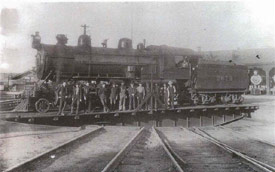
Judah’s plan in 1863 was to build a roundhouse at Junction, now Roseville, to service the extra engines that would be needed to help trains surmount the Sierra. But Judah died that year and new CP managers decided to build the roundhouse at Rocklin instead, closer to the point where the rail bed steepens as it heads toward Auburn. . According to railroad historian G. J. Chris Graves engines of the 1860s required new fuel and water at regular intervals and Rocklin was at a more appropriate distance from Sacramento for a train’s first stop. The decision to build in Rocklin also reflected Rocklin’s proximity to large stands of oak and pine. Each engine required 16 cords of firewood on its strain to the Sierra summit.
The Rocklin facility was located at the intersection of Front Street and Granite (now Rocklin Road) east of today’s 180 Church. It opened in May 1867. It included 25 engine stalls, a turntable and an 8,000 square foot woodshed.
The roundhouse’s foundation and exterior walls were constructed of rock and masonry but early undated photos show significant wooden construction in the roofing and stalls.
In 1869 the woodshed burned and was quickly rebuilt.
In 1873 the roundhouse burned again as its roof was being tarred. The fire destroyed ten engines and damaged several coaches but the facility continued to function without interruption.
Rocklin’s roundhouse was in service continually until 1905 when railroad management announced a major expansion. Townspeople were elated and Rocklin’s property values soared as news came of a new and larger roundhouse for Rocklin and a new train station. But hopes were crushed in 1906 with news that Rocklin’s roundhouse would soon be closing in favor of new facilities in Roseville. Railroad managers had decided that Rocklin’s granite quarries to the east and residential development to the west limited options for expansion. Also, Rocklin’s booming granite industry was driving up land values; land in Roseville was less expensive. By April 1908 the railroad had moved all roundhouse operations to Roseville and the Rocklin facility closed permanently.
In its heyday, just prior to its move to Roseville, Rocklin’s roundhouse employed 300 people. The monthly payroll was $25-30,000. . A report from the time asserts that, from 1906 through 1908, Rocklin’s population declined by 80% as roundhouse workers abandoned their homes or moved them to Roseville.
By 1912 Rocklin’s abandoned roundhouse had become a dangerous eyesore and Rocklin’s City Council required the railroad to demolish it. The foundation, and parts of the west-facing exterior rock wall are still visible near the Crossroads Church.
The Rocklin Historical Society celebrated the hundredth anniversary of the loss of Rocklin’s roundhouse to Roseville at Rocklin’s annual Legacy Dinner on May 14, 2008
